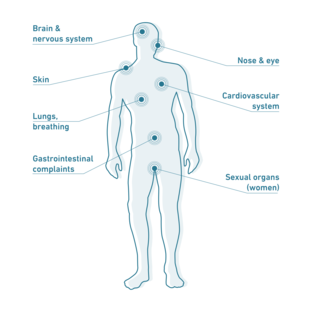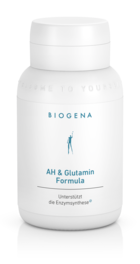Histamine intolerance has many faces and even more potential triggers. It is no wonder that sufferers often have a long and rocky path before they can make the diagnosis of "histamine intolerance". However, even with the knowledge of what it is, many affected individuals find life with intolerance challenging. Find out more about the often undetected phenomenon, symptoms of which can manifest as histamine intolerance and what the right diet looks like with this intolerance.
What is histamine intolerance?
In the case of histamine intolerance, the ratio between the breakdown of histamine and its formation in the body or its intake with food is not in balance. This imbalance can lead to an excess of histamine in the body, which, above a certain amount, can cause a variety of symptoms.
The tolerance level varies from person to person. In fact, even healthy people can only tolerate a certain amount of histamine.
If a person has a histamine intolerance, their body cannot break down the histamine it has absorbed or produced completely or only too slowly. If the breakdown does not work properly, the histamine from food can take effect in the body and trigger different symptoms that vary from person to person.
The body's own enzyme diamine oxidase (DAO), which is mainly produced by the cells of the intestinal mucosa but is also found in the blood, plays a key role in the breakdown and the associated disruption.
The causes of histamine intolerance
In most cases, decreased activity or production of the histamine-degrading enzyme DAO is responsible for histamine intolerance (colloquially known as DAO deficiency or DAO disorder).
This can be genetically determined, but it can also be caused by inflammation of the intestinal mucosa (e.g. Crohn's disease, irritable bowel syndrome) – in inflamed intestinal mucosa, little or no DAO can be produced and thus histamine cannot be broken down sufficiently.
Normally, DAO is continuously released into the intestines to break down the ingested histamine from food before it triggers physical reactions. However, this degradation system can be overwhelmed by an increased histamine load, leading to allergy-like symptoms.
In addition to breaking down histamine, DAO is also responsible for breaking down other biogenic amines (including serotonin, tyramine and putrescine). If the capacity of the DAO for the preferred degradation of other biogenic amines is exhausted, it is no longer available to a sufficient extent for the degradation of histamine. A histamine-rich diet with many biogenic amines can exceed the capacity of the DAO and intensify the symptoms.
A bacterial overgrowth in the gut (e.g. SIBO) can further intensify histamine intolerance because certain bacteria have the peculiarity of forming histamine from the protein component histidine.
A deficiency of certain micronutrients that are crucial for DAO activity can also be important. DAO particularly requires vitamin B6, but also copper, vitamin C and zinc, to function properly. A deficiency of these substances results in DAO deficiency.
Which micronutrients are beneficial for people with histamine intolerance?
Vitamin B6 & copper: important for the enzymatic breakdown of histamine
Diamine oxidase (DAO) is a copper-containing enzyme that breaks down histamine and requires vitamin B6 to do so. A vitamin B6 deficiency can reduce DAO activity, while a copper deficiency reduces the production of the enzyme. In addition, zinc supports the function of DAO and at the same time inhibits the release of histamine.
Histamine opponent vitamin C
In addition to vitamin B6, copper and zinc, vitamin C has also proven to be beneficial for people with histamine intolerance. This water-soluble vitamin acts as an antagonist to histamine in the metabolism and supports its breakdown.
External factors can also disrupt the activity of histamine-degrading diamine oxidase (DAO). This is because it is a sensitive molecule that is not located in a controlled environment within the cell, as is the case with most enzymes, but functions outside the cell and is thus exposed to various disruptive influences.
Some of the most important inhibitors of DAO include alcohol and nicotine. Certain medication agents such as acetylsalicylic acid (ASA), diclofenac, indometacin, flurbiprofen, meclofenamic acid or naproxen can reduce the activity of DAO or even block it almost entirely. If medication is taken, it is therefore recommended to find out whether it can potentially block DAO.
Causes of too much histamine during the menopause
Women are more likely to suffer from histamine intolerance. While pregnancy can have a positive effect on histamine intolerance, there is a significant increase in cases around the menopause. In fact, 80% of histamine patients are middle-aged women. Scientists suspect that the cause of this is the hormonal changes that occur during the menopause, because female hormones influence both the sensitivity of histamine receptors and the release of histamine.
Symptoms of histamine intolerance
Histamine is a versatile messenger substance that performs numerous functions in the body. Accordingly, the symptoms that can be triggered by a histamine imbalance are also multifaceted and individual. In addition, individual physical factors and the histamine concentration influence the appearance of the symptoms. Possible symptoms of histamine intolerance include:

- Nose & eyes: swelling of the nasal mucosa, runny or blocked nose, watery eyes
- Skin: flushing (redness, especially on the face), skin rash, itching, wheals
- Lungs, breathing: tickly throat, sneezing, breathing problems, asthma symptoms
- Cardiovascular system: dizziness, blood pressure fluctuations, cardiac arrhythmias
- Brain and nervous system: nausea, vomiting, headaches, migraine attacks
- Gastrointestinal complaints: heartburn, abdominal pain, cramps, diarrhoea, bloating
- Genitals (women): increased menstrual cramps

How histamine intolerance affects the psyche
For people with histamine intolerance, the constant struggle with physical symptoms can lead to increased stress and anxiety. However, it is precisely this mental strain that can become another histamine trap. After all, psyche and histamine influence each other. Today, we know that stress triggers the release of histamine in the body. This in turn leads to a wide range of reactions – including at the level of the brain and psyche. Symptoms that can be associated with histamine intolerance include depression, anxiety, nervousness, confusion and sleep disorders.
Foods and their histamine content
‘How much histamine is in...?’ Dr Google invites people with histamine intolerance to pore over tables. Not only those affected despair when they come to the conclusion that they are actually no longer allowed to eat anything at all thanks to the table jungle. But you shouldn't let this drive you crazy.
Of course, there are certain foods that are real histamine bombs due to the way they are aged or manufactured – these include, for example, ripened cheese, bacon, prosciutto, salami, sparkling wine and sauerkraut.
Care should also be taken with processed foods, which often contain problematic additives such as yeast extract, colourings or preservatives. Alcohol is also problematic because it blocks the histamine-degrading enzyme DAO in the body. Red wine and sparkling wine in particular contain a lot of histamine.
However, for many other foods, no reliable statement can be made about the exact histamine content, as this can change hourly.
Although fresh food and freshly prepared meals do not automatically have less histamine, they do present a lower risk of intolerance. However, if food is stored or precooked for a long time, more histamine can be formed by heating and storing, so that a meal that was tolerated the day before can cause discomfort the next day. The same applies to the ripening of food: the longer it ripens, the more critical it is for histamine intolerants – such as aged cheese or salami.
How can you test for histamine intolerance?
The diagnosis of histamine intolerance is primarily based on a detailed questioning of the doctor (anamnesis) about the health history of the patient. In the course of this, the observations and complaints of the person concerned are recorded.
Blood tests can also be consulted at a later stage. Measuring the activity of the histamine-degrading enzyme DAO and determining the DAO and histamine levels are not conclusive as individual methods, but they do help to confirm the suspected diagnosis of histamine intolerance. As part of the laboratory diagnosis, histamine can be determined in the urine and serum, and the activity of DAO can be determined in the serum.
On this basis, those affected can try to eat a low-histamine diet for three to four weeks, i.e. to observe a histamine-free period. In the course of this, foods and drinks containing histamine and those that release histamine should be avoided as far as possible. In addition, keeping a food diary helps to correlate nutrition and symptoms. If there is a significant improvement in symptoms during this phase, this is a strong indication of histamine intolerance.
Treating histamine intolerance
Change of diet
For histamine intolerance, a change in diet to a more or less histamine-free diet is the be-all and end-all. The change in diet should begin with a waiting period, then move on to a test phase and end with an individually designed long-term diet.
- Waiting period: During the waiting period of up to three weeks, foods containing histamine and histamine-releasing foods should be avoided if possible. A DAO supplement can also help during this time to reduce dietary histamine to a minimum. To relieve the digestive tract as much as possible, foods that cause bloating and foods high in fibre should not be consumed during this time.
- Test phase: As soon as you are free of symptoms, the test phase can begin. In the beginning, only one moderately histamine-containing food is consumed in small quantities once a day, before the histamine content of the food is gradually increased in a slow and controlled manner. A food and symptom diary helps you keep track of the tolerability and intolerance of individual foods during this time.
- Long-term nutrition: Once the individual threshold for tolerating foods containing histamine has been determined, the long-term nutrition phase begins. In this phase, the accumulated knowledge is implemented in daily practice and thus becomes applicable to everyday life.
Enzyme replacement therapy: DAO capsules
Whether it's a holiday abroad or dinner with friends – even people who have learned to cope well with their intolerance are repeatedly faced with histamine-critical situations. However, there are now ways and means of arming yourself for such cases. Innovative dietary supplements supply histamine-degrading DAO (diamine oxidase) in a targeted manner, thus increasing the amount of DAO in the small intestine. Taken immediately before a meal, DAO capsules or tablets improve histamine breakdown in the digestive tract. This means that histamine from food that causes irritation is eliminated more quickly and a flood of histamine is counteracted. Preparations that also supply L-glutamine are an insider tip. The amino acid strengthens the cells of the intestinal mucosa that are attacked by the intolerance and thus supports the body's own DAO formation.
What else can you do if you are intolerant to histamine?
Mental coping strategies for histamine intolerance
To improve well-being in the case of histamine intolerance, it is important to treat both body and mind holistically. In addition to a change in diet, important coping strategies for histamine intolerance include mindfulness training, stress management, psychotherapy and self-help groups, where appropriate.
- Mindfulness training can help you to better manage the negative thoughts and emotions associated with intolerance. This reduces the psychosomatic component of the condition (see: ‘How histamine intolerance affects the psyche’).
- Stress management: Stress management techniques can also help to reduce the psychosomatic component. Possible techniques include yoga, breathing exercises, meditation, forest bathing and getting enough sleep.
- Psychotherapy can help you to recognise the psychological effects of histamine intolerance, as well as negative thought patterns and behaviours.
- Self-help groups: For some people, talking to others in the same situation can help. It makes them feel understood and less isolated.
Conclusion: Living with histamine intolerance can be challenging. On the one hand, the ‘histamine problem’ affects many food groups, and on the other hand, the symptoms are multifaceted and have a lasting negative impact on well-being. In order to lead an enjoyable life despite histamine intolerance, it is therefore important to know your ‘enemies’. In addition to certain foods, stress is also a histamine trap that should not be neglected. This makes not only a low-histamine diet but also effective stress management important for histamine intolerance. Those affected who want to relieve their bodies, eat out or break away from their histamine-reduced diet can also take special preparations that supply the enzyme DAO in a targeted manner and thus quickly and easily support the body in breaking down histamine.
Sources:
Hakl R., Litzman J. 2023. Histamine intolerance. Vnitr Lek. 2023 Winter;69(1):37-40. doi: 10.36290/vnl.2023.005. https://pubmed.ncbi.nlm.nih.gov/36931880/ Access: 15.3.2024.
Schnedl W.J., Enko D. 2021. Nutrients. 2021 Apr 12;13(4):1262. doi: 10.3390/nu13041262. https://pubmed.ncbi.nlm.nih.gov/33921522/ Access: 15.3.2024.
Sánchez-Pérez S. et al. 2022. Intestinal Dysbiosis in Patients with Histamine Intolerance. Nutrients. 2022 Apr 23;14(9):1774. doi: 10.3390/nu14091774. https://pubmed.ncbi.nlm.nih.gov/35565742/ Access: 15.3.2024.
Ledochowski M. 2014: Nahrungsmittelintoleranzen. Unverträglichkeiten erkennen und gut damit leben. Trias Verlag.
Vogelreuter A. 2015: Nahrungsmittelunverträglichkeiten. Laktose. Fruktose. Histamin. Gluten. S. Hirzel Verlag Stuttgart.
Wolzt M, Feffer-Holik S, 2013: Gesund und trotzdem krank. Verlagshaus der Ärzte.
Ärzteblatt. https://www.aerzteblatt.de/archiv/53958/Die-verschiedenen-Gesichter-der-Histaminintoleranz , Access: 15.3.2024.









